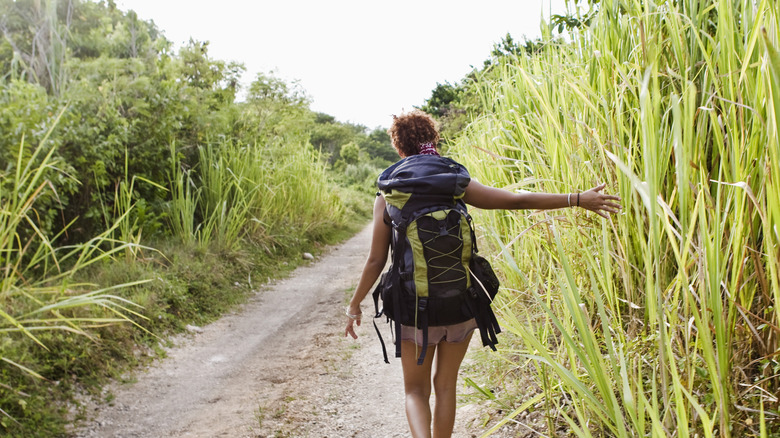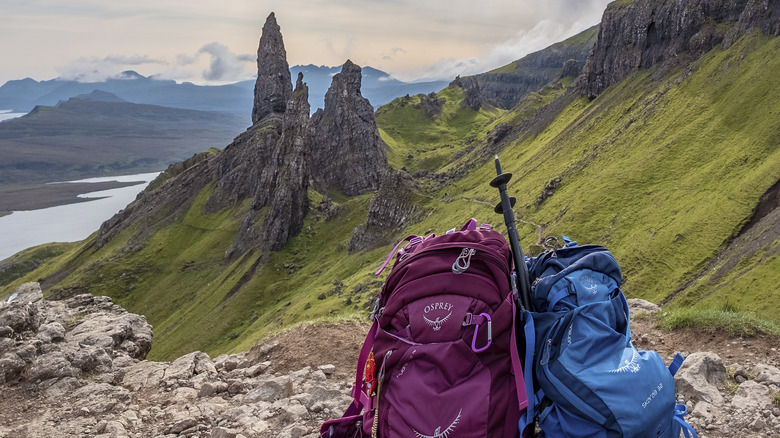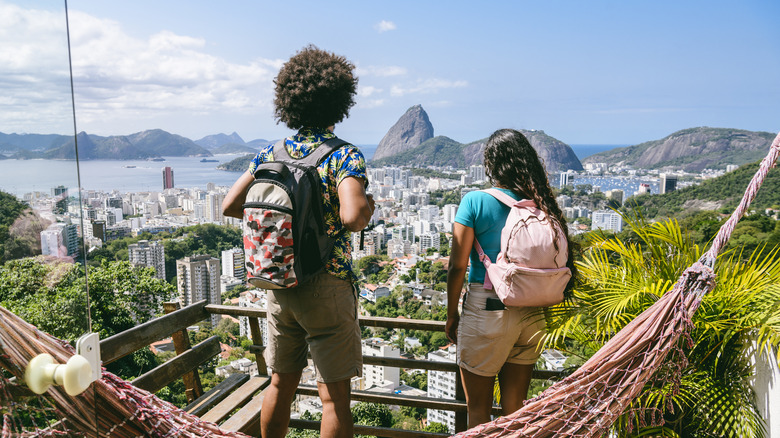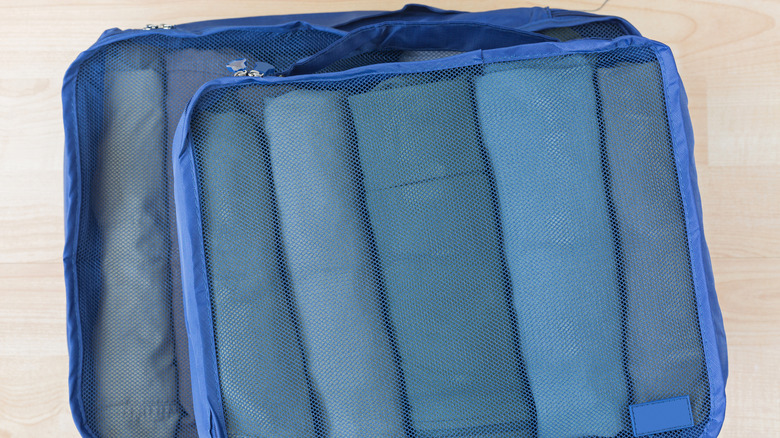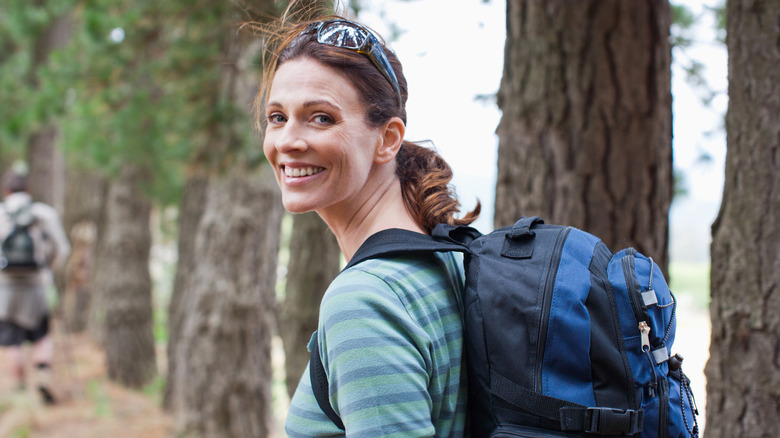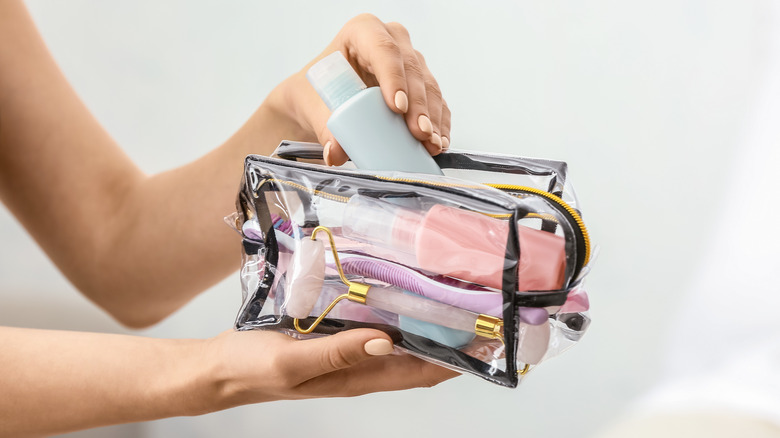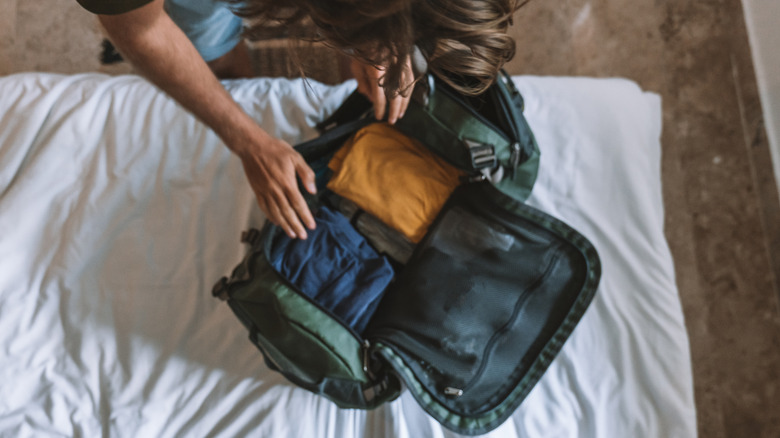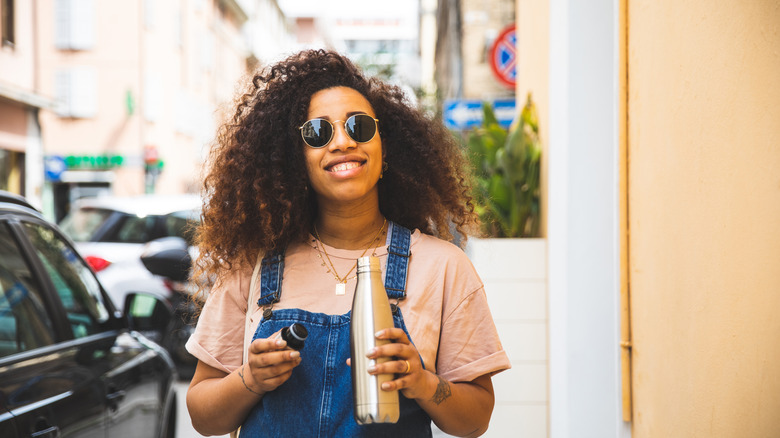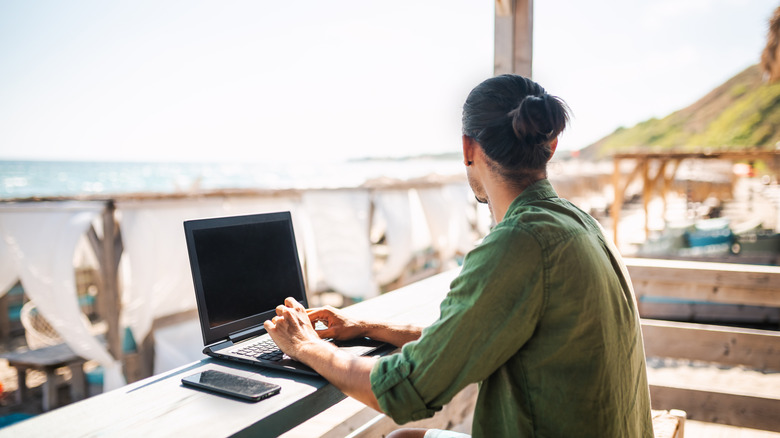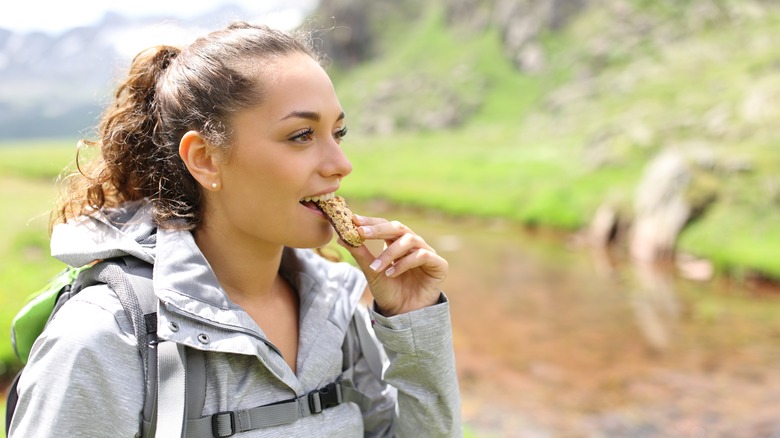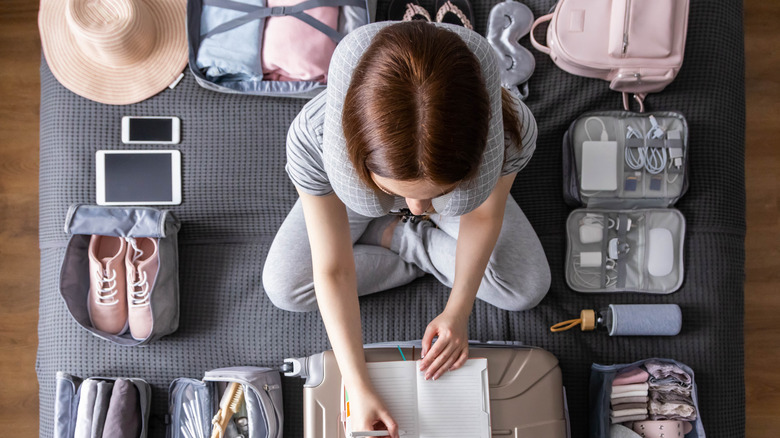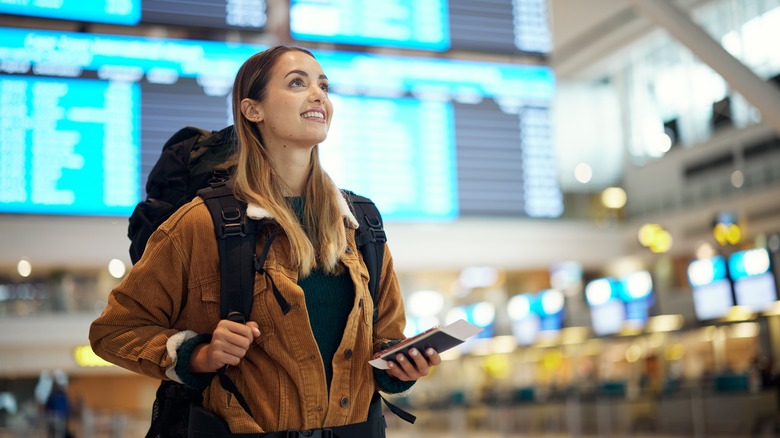Everything You Need To Know About Packing For Your Budget Backpacking Trip
This is it — the moment you've been waiting for. Not much comes close to the feeling of setting off on your first budget backpacking trip. Crazy excitement, nerves, anticipation ... You're about to taste sweet freedom and learn more about yourself than you ever have before. Think of the people you'll meet, the exotic foods you'll try, and the jaw-dropping places you'll visit that others only dream of.
Backpacking, whether it's through Europe, Southeast Asia, or South America, has become a rite of passage for many travelers. However, before you start climbing mountains, visiting temples, rafting rivers, uncovering ancient ruins, and exploring tropical jungles, you'll need to clear the first hurdle, and that's packing. It might feel like an uphill battle right now, and maybe you're a little overwhelmed with everything you have to prepare, but if you lean into the idea that packing is one of the most exciting pre-trip activities you can do, it'll be much more enjoyable. Plus, it's a great way to sharpen your organizational skills, which you'll definitely need on the road.
From power banks and microfibre towels to makeup bags and plain white tees, find out which items you should definitely carry along with you on your trip, and which items are best left at home. What's more, we've rounded up all the top tips for organizing your bag (and keeping it as light as possible).
Buy a quality backpack
To be a real backpacker, you need to get yourself a real backpack. Not just any old bag will do. When choosing a backpack, you're looking for something that's sturdy, durable, and comfortable, with strong zips and a number of different compartments. Bonus points if it comes with a waterproof cover, too. Buying a name-brand bag, such as Osprey or Tortuga, might set you back a few extra bucks, but these brands are popular for a reason. These bags may last you for decades, saving you money in the long run, and there's nothing worse than a broken zipper (or soar back) when you're on the road.
The next decision you need to make is what size backpack to go for. Don't stray outside the measurements of 40L to 75L — the exact size you decide on will depend on where you're going, and how long you're planning to be away for. Keep in mind that a 40L to 45L backpack can usually be taken on a plane as a carry-on, which will save you extra baggage fees, but it might be too small for a long trip. On the other hand, the bigger the bag, the more stuff you're likely to take along with you (just in case) — which will weigh you down. So, as a general rule of thumb, choose backpacks in the 55L to 75L range if you're planning to be away for a year or longer, and opt for something in the 40L to 50L range for shorter trips — a week to a few months.
Research where you're going and pack accordingly
Before you start on anything else, really do your homework when it comes to the countries and regions you're planning to explore. Is it going to be hot, humid, and sunny 90% of the time? Taking more than two jumpers may be unnecessary, but loose-fitting clothes like baggy tees made of cotton, a pair of sunglasses, and sweat-absorbent shorts will be a better use of space. On the flip side, if it often snows at your destination, or tends to rain quite a lot, a raincoat, closed-toe shoes (and maybe snow boots), a windproof jacket, and an umbrella are going to be better suited to you.
Think about the type of activities you want to get involved in as well — will you be following countless long-distance hiking trails, sticking to the big cities, or lounging on sun-kissed beaches 24/7? This sort of question should help you decide on the type of footwear to bring, such as how many pairs of sneakers or boots you might want, or if comfortable sandals and a pair of flip-flops are all you need.
Use packing cubes
The golden tool of backpacking — packing cubes. They're a game changer and a secret weapon that not everyone seems to know about. They're so useful that they're one of the few universal staples that all travelers can agree on. These handy companions keep everything neat, tidy, and organized, but they're even better if you buy the compression cube versions. Don't underestimate the benefits of being able to unpack all your stuff in seconds, and repack it all just as fast.
You might plan to be super organized and on the ball for your whole trip — but there will be times when things go a little wrong. Maybe you need to pack in a rush to catch a train or a bus after checking out of your accommodation after oversleeping. That's when packing cubes really come into their own.
Learning how to use packing cubes efficiently will help level up your packing game and allow you to spend more time on the moments that really matter. You can find countless packing cubes online. Go for a bundle of different sizes, and make sure they feature compression zips.
Pack as light as possible
Keep the weight down wherever you can. It's not much fun traveling across rice fields, dirt tracks, lakes, mountain passes, and beaches with a backpack that's filled to the brim and heavy as a lead balloon. Try to aim for the 20-pound mark — a very comfortable weight for a day's travel between destinations. Packing light looks like taking enough clothes for a week to 10 days, which you can do by following the 54321 packing rule. This means taking clothes you can wear for both day and night time, or with a combination of other items you've packed. You might want to include two week's worth of underwear (for peace of mind), but that's it.
Don't worry about having to re-wear items, either. In fact, you'll probably always gravitate towards the same comfortable tee or pair of shorts, no matter how many clothes you bring with you. Besides, many destinations and hostels offer laundry as a service, so you're likely to have clean clothes whenever you need them. Finally, when the time comes to leave for your trip, wear the bulkiest items on the plane — think sneakers, sweaters, and clothing that doesn't roll up as easily. It'll save you heaps of space in your backpack for more important goodies.
Include these toiletries
Don't fall into the very easy trap of bringing too many toiletries — these are often much better to buy at your destination than pack in your bag. Deodorant, sunscreen, and shampoo all fit into this category, but there are a few select items you might want to have with you from the get-go. Be sure to pack a hanging toiletries bag that can roll up easily to fit in your backpack. It stops your bathroom items from leaking onto your clothes and allows you to hang toiletries up on hooks as you shower in shared bathrooms. Nifty, right? This leads us to an all-in-one soap bar, which is great for hair, face, and body use. It will last you longer than shower gel and saves space, too.
If you have a skin condition or sensitive skin, and you're quite particular about your skincare routine, consider squeezing in some of your essential items from home. Whether that's a cleanser, toner, moisturizer, cream, or all of the above. You might not be able to find the same brands abroad, so it's better to play it safe than risk having a flare-up while you're traveling. Finally, a toothbrush holder or cover is perfect for keeping your toothbrush head squeaky clean when it's packed away. Just remember to rinse and dry it after each use.
Take these clothes and shoes
Start with loose tees, shorts, and trousers. They're handy for keeping you cool in warm weather and a real comfort on travel days. One or two nice dresses that can be worn day or night are all you'll need for going out, so be really ruthless here. If you're venturing to cooler climates, go for items that keep you warm but don't take up much space — think jeans, long-sleeved tees, and jumpers.
While we're on the topic of covering up, it's important to have one or two modest clothing options for visiting temples or mosques, or if you plan to explore certain countries with a more conservative dress code, like India. Wraparounds are perfect for this — they're light to pack, can be worn with multiple items, and look pretty stylish. For guys, pack a couple of overshirts. Don't be tempted to bring too much swimwear — it will take up valuable space, and you just won't wear it all. Go for two bikinis or swim shorts at a maximum, alongside one raincoat, and one set of pajamas.
If you plan to hike a lot, two pairs of trainers should work, but otherwise, just the one will do. Open-toe sandals that are comfortable for walking in all day, as well as wearing out at night, are unbeatable in humid climates, but choose closed-shoe options for cooler temperatures. Don't forget your flip-flops, either. These are great for wearing in hostel showers to stop you from catching any nasty infections.
Pack these miscellaneous items
You'll want to consider a handful of other bits, such as a fanny pack and a tote bag. Each takes up little space and can be useful for short trips to the supermarket or the beach. While tap water isn't drinkable everywhere, do your bit for the planet when it is by bringing a reusable water bottle, or even better, a filtered water bottle. Speaking of water, microfibre towels are up next. They're absorbent, dry easily, and can be rolled up small in your bag. Many travelers take two — one for showers and one for the beach — but it's up to you.
A lanyard is great for keeping your phone away from pickpockets, and don't forget padlocks, power banks for emergency charging, and multi-plug adapters. Go for combination padlocks over lock and key — you won't need to keep track of where the key is all the time, and they're perfect for keeping your things safe in hostel lockers. Ear plugs and an eye mask work wonders for blocking out light and noise at night, and insect repellent is a non-negotiable for backpacking in South America and Southeast Asia. Although getting sick while traveling isn't a given, you can put your mind at rest by bringing a first aid kit with you as well. Make sure this includes plasters, painkillers, bandages, oral rehydration salts, and travel sickness tablets.
Leave these things at home
Whether you've got heaps of space left, or your clothes pile needs to be halved in size, be strict and stick to your packing list. That means being clear on what you absolutely shouldn't take, and the number one item on this list is anything white. Your white tees and shorts may look fresh now, but they'll end up so dirty and ruined that you'll have to throw them away, so keep these at home. The same goes for makeup bags — an eyeliner or mascara will be fine, but don't take a full makeup set. You won't use it in hot, humid weather and hostel life means you often move from one activity to the next, with little chance to doll yourself up in between.
Also, avoid packing outfits for every occasion, and ask yourself if you'll regularly wear every piece in your "yes" pile. Any more than this risks being overkill. For beach trips and travel days, reading material is key, but don't bring books. Opt for a Kindle or an e-reader instead — they're much lighter and you can download multiple books at any one time. If you can't get hold of one, hostels tend to have a bookshelf in reception that you can borrow from. The last no-no on this list is heavy electronics. Take your laptop if you need it for work, but bulky equipment like keyboards, headphones, or video cameras will quickly send the weight of your bag over that magic 20-pound mark.
To take food or not to take food?
In short, try to avoid it. It's just another item to weigh your bag down with. And besides, your food could end up attracting rats or ants — other travelers in your hostel dorm room won't thank you for that. While you might not find many brands you're familiar with on the backpacker trail, there are always similar alternatives you can get your hands on. It's also typically pretty easy to spend less on food while traveling when eating wisely. Think street food and hostel-made meals. So, feel free to go out and explore all those new tastes, smells, and textures, without worrying too much about your bank balance. Trying new foods is one of the most rewarding parts of being on the road, so really make the most of it.
The only exception to this rule is if you're allergic or intolerant to certain ingredients, and you're worried about finding enough snacks you can actually eat. In this case, bring a supply of your favorite goodies and make sure they travel well, like nuts and granola bars. Don't forget to pack a few small elastic bands with you, too. They'll keep your items sealed at all times, which can help to stop nasty critters from finding their way in.
Strategically lay out your gear before you pack it
The best way to make sure you have everything you need when packing for your trip, and nothing you don't need, is to lay out what you want to take with you first. Do this on a flat surface, like the floor or on a bed, and separate each of your things into three clear categories: need, really want, and bonus items. It sounds pretty simple, but this can help you narrow down what to pack based on how heavy that "need" pile is feeling, and what to throw in the "bonus items" corner.
You'll also want to do a dummy run (or three) before you pack for good, so pay attention every time you go through this process. It might sound a little dull to you now, but remember, you'll be packing, unpacking, and repacking your bag continuously on your traveling journey. So, getting in lots of packing practice — knowing what goes where in your bag, and in what order, is going to be a game changer, and something that can help save you valuable time along the way.
Keep a safe space for all your documents
The last — but probably most important thing to consider — is where you're going to store your travel documents. You'll want to pick somewhere with easy access, but not so easy that they could be stolen. Hidden yet accessible compartments in a backpack or a day pack are great for this, but wearing a fanny pack around your waist, or over the shoulder, gives you another option. Remember to always keep your backpack on while traveling, or any bag for that matter. Leaving it lying somewhere, even for just a few minutes, increases the risk of your things being stolen, and you really don't want that.
It's a good idea to use a clear, plastic wallet for storing copies of your passport identification page, any visas you might need, vaccination certificates, or other health information, and valid travel insurance documents. This works really well for making sure all your essential items are clean and presentable. However, you'll want to keep these documents locked up whenever possible.
When it comes to keeping your valuables safe while traveling, keep your passport, airline tickets, driver's license, and credit cards in a fanny pack or a money belt, which helps to keep your most valuable belongings undetectable to would-be thieves. Lastly, it's always a good idea to separate some cash from your other valuables, just in case one of your bags does go missing.
